Effect of Rainfall and pH on Musty Odor Produced in the Sanbe Reservoir
Abstract
:1. Introduction
2. Materials and Methods
2.1. Study Site
2.2. Sampling and Analysis of Geosmin and 2-Methylisoborneol (2-MIB)
2.3. Vertical Distribution of Water Quality
2.4. Observations of Morphological Characteristics and Counting of Cell Numbers for Phytoplankton
2.5. Establishment of Laboratory Culture
2.6. Analysis of Nucleotide Sequences
3. Results and Discussion
3.1. Variation Characteristics of Geosmin and 2-MIB in Sanbe Reservoir
3.2. Identification of Phytoplankton and Musty Odor-Producing Species
3.3. Effect of Rainfall on Geosmin and 2-MIB
3.4. Effect of pH and Water Temperature on the Cyanobacteria
3.5. Relationship between Cyanobacteria and Rainfall
4. Conclusions
Supplementary Materials
Author Contributions
Funding
Institutional Review Board Statement
Informed Consent Statement
Data Availability Statement
Acknowledgments
Conflicts of Interest
References
- Chorus, I.; Bartram, J. Toxic Cyanobacteria in Water: A Guide to Their Public Health Consequences, Monitoring and Management; E & F Spon: London, UK, 1999. [Google Scholar]
- Paerl, H.W.; Fulton, R.S., 3rd; Moisander, P.H.; Dyble, J. Harmful freshwater algal blooms, with an emphasis on cyanobacteria. Sci. World J. 2001, 1, 76–113. [Google Scholar] [CrossRef] [PubMed]
- O’Neil, J.M.; Davis, T.W.; Burford, M.A.; Gobler, C.J. The rise of harmful cyanobacteria blooms: The potential roles of eutrophication and climate change. Harmful Algae 2012, 14, 313–334. [Google Scholar] [CrossRef]
- Paerl, H.W.; Otten, T.G. Harmful Cyanobacterial Blooms: Causes, Consequences, and Controls. Microb. Ecol. 2013, 65, 995–1010. [Google Scholar] [CrossRef]
- Chong, S.; Lee, H.; An, K.G. Predicting Taste and Odor Compounds in a Shallow Reservoir Using a Three-Dimensional Hydrodynamic Ecological Model. Water 2018, 10, 1396. [Google Scholar] [CrossRef] [Green Version]
- Nowruzi, B.; Porzani, S.J. Toxic compounds produced by cyanobacteria belonging to several species of the order Nostocales: A review. J. Appl. Toxicol. 2020, 41, 510–548. [Google Scholar] [CrossRef]
- Zerrifi, S.E.; Mugani, R.; Redouane, E.; El Khalloufi, F.; Campos, A.; Vasconcelos, V.; Oudra, B. Harmful Cyanobacterial Blooms (HCBs): Innovative green bioremediation process based on anti-cyanobacteria bioactive natural products. Arch. Microbiol. 2021, 203, 31–44. [Google Scholar] [CrossRef]
- Smith, V.H.; Sieber-Denlinger, J.; deNoyelles, F.; Campbell, S.; Pan, S.; Randtke, S.J.; Blain, G.T.; Strasser, V.A. Managing taste and odor problems in a eutrophic drinking water reservoir. Lake Reserv. Manage. 2002, 18, 319–323. [Google Scholar] [CrossRef] [Green Version]
- Zaitlin, B.; Watson, S.B. Actinomycetes in relation to taste and odour in drinking water: Myths, tenets and truths. Water Res. 2006, 40, 1741–1753. [Google Scholar] [CrossRef]
- Jüttner, F.; Watson, S.B. Biochemical and ecological control of geosmin and 2-methylisoborneol in source waters. Appl. Environ. Microbiol. 2007, 73, 4395–4406. [Google Scholar] [CrossRef] [Green Version]
- Su, M.; Gaget, V.; Giglio, S.; Burch, M.; An, W.; Yang, M. Establishment of quantitative PCR methods for the quantification of geosmin-producing potential and Anabaena sp in freshwater systems. Water Res. 2013, 47, 3444–3454. [Google Scholar] [CrossRef]
- Suurnäkki, S.; Gomez-Saez, G.V.; Rantala-Ylinen, A.; Jokela, J.; Fewer, D.P.; Sivonen, K. Identification of geosmin and 2-methylisoborneol in cyanobacteria and molecular detection methods for the producers of these compounds. Water Res. 2015, 68, 56–66. [Google Scholar] [CrossRef] [PubMed]
- Watson, S.B.; Monis, P.; Baker, P.; Giglio, S. Biochemistry and genetics of taste- and odor-producing cyanobacteria. Harmful Algae 2016, 54, 112–127. [Google Scholar] [CrossRef] [PubMed]
- Pham, T.L.; Bui, M.H.; Driscoll, M.; Shimizu, K.; Motoo, U. First report of geosmin and 2-methylisoborneol (2-MIB) in Dolichospermum and Oscillatoriafrom from Vietnam. Limnology 2021, 22, 43–56. [Google Scholar] [CrossRef]
- Gerber, N.N.; Lecheval, H. Geosmin an Earthy-Smelling Substance Isolated from Actinomycetes. Appl. Microbiol. 1965, 13, 935. [Google Scholar] [CrossRef]
- Medsker, L.L.; Jenkins, D.; Thomas, J.F.; Koch, C. Odorous Compounds in Natural Waters—2-Exo-Hydroxy-2-Methylbornane Major Odorous Compound Produced by Several Actinomycetes. Environ. Sci. Technol. 1969, 3, 476. [Google Scholar] [CrossRef]
- Rosen, A.A.; Mashni, C.I.; Safferman, R.S. Recent developments in the chemistry of odour in water: The cause of earthy/musty odour. Water Treat. Exam. 1970, 19, 106–119. [Google Scholar]
- Godo, T.; Ohtani, S.; Saki, Y.; Ishitobi, Y. Detection of geosmin from Coelosphaerium kuetzingianum separated by a step density gradient medium from suspended materials in water in Lake Shinji, Japan. Limnology 2011, 12, 253–260. [Google Scholar] [CrossRef]
- Godo, T.; Saki, Y.; Nojiri, Y.; Tsujitani, M.; Sugahara, S.; Hayashi, S.; Kamiya, H.; Ohtani, S.; Seike, Y. Geosmin-producing Species of Coelosphaerium (Synechococcales, Cyanobacteria) in Lake Shinji, Japan. Sci. Rep. 2017, 7, 41928. [Google Scholar] [CrossRef] [PubMed] [Green Version]
- Hayashi, S.; Ohtani, S.; Godo, T.; Nojiri, Y.; Saki, Y.; Esumi, T.; Kamiya, H. Identification of geosmin biosynthetic gene in geosmin-producing colonial cyanobacteria Coelosphaerium sp. and isolation of geosmin non-producing Coelosphaerium sp. from brackish Lake Shinji in Japan. Harmful Algae 2019, 84, 19–26. [Google Scholar] [CrossRef]
- Srinivasan, R.; Sorial, G.A. Treatment of taste and odor causing compounds 2-methyl isoborneol and geosmin in drinking water: A critical review. J. Environ. Sci. 2011, 23, 1–13. [Google Scholar] [CrossRef]
- Hsieh, W.H.; Chang, D.W.; Lin, T.F. Occurrence and removal of earthy-musty odorants in two waterworks in Kinmen Island, Taiwan. J. Hazard. Toxic Radioact. Waste 2014, 18, 04014012. [Google Scholar] [CrossRef]
- Saijo, Y.; Mitamura, O. Shinpen Koshochosahou; Kodansha Scientific: Tokyo, Japan, 1995. (In Japanese) [Google Scholar]
- Pringsheim, E.G. Pure Culture of Algae, Their Preparation and Maintenance 19; Cambrige University Press: Cambridge, UK, 1964. [Google Scholar]
- Ichimura, T.; Watanabe, M. The Closterium calosporum complex from the Ryukyu Islands-Variation and taxonomical problems. Mem. Natl. Sci. Mus. Tokyo 1974, 7, 89–102. [Google Scholar]
- Someya, T. Three-Dimensional Observation of Soil Bacteria in Organic Debris with a Confocal Laser Scanning Microscope. Soil Microorg. 1995, 46, 61–69. [Google Scholar]
- Someya, T.; Wang, X.; Gong, C.; Koshida, K.; Nakagawa, H.; Tanaka, C.; Ishibashi, M.; Yokobori, K.; Inoue, K. Rapid and SpecificDetection and Enumeration of Microorganisms in Soil and Manure. Soil Microorg. 2003, 57, 115–123. (In Japanese) [Google Scholar]
- Kakimoto, M.; Ishikawa, T.; Miyagi, A.; Saito, K.; Miyazaki, M.; Asaeda, T.; Yamaguchi, M.; Uchimiya, H.; Kawai-Yamada, M. Culture temperature affects gene expression and metabolic pathways in the 2-methylisoborneol-producing cyanobacterium Pseudanabaena galeata. J. Plant Physiol. 2014, 171, 292–300. [Google Scholar] [CrossRef]
- National Center for Biotechnology Information. Available online: https://www.ncbi.nlm.nih.gov (accessed on 1 January 2021).
- Japan Meteorological Agency Database. Available online: https://www.jma.go.jp (accessed on 1 January 2021).
- Cooper, T.G.; Filmer, D. The active species of CO2 utilized by ribulose diphosphate carboxylase. J. Biol. Chem. 1969, 244, 1081–1083. [Google Scholar] [CrossRef]
- Raven, J.A. Inorganic carbon acquisition by marine autotrophs. Adv. Bot. Res. 1997, 27, 85–209. [Google Scholar]
- Kaplan, A.; Reinhold, L. CO2 concentrating mechanisms in photosynthetic microorganisms. Annu. Rev. Plant Physiol. Plant Mol. Biol. 1999, 50, 539. [Google Scholar] [CrossRef]
- Tortell, P.D.; Morel, F.M.M. Sources of inorganic carbon for phytoplankton in the eastern Subtropical and Equatorial Pacific Ocean. Limnol. Oceanogr. 2002, 47, 1012–1022. [Google Scholar] [CrossRef]
- Nakajima, K.; Tanaka, A.; Matsuda, Y. SLC4 family transporters in a marine diatom directly pump bicarbonate from seawater. Proc. Natl. Acad. Sci. USA 2013, 110, 1767–1772. [Google Scholar] [CrossRef] [Green Version]
- Morel, F.M.M.; Herring, J.G. Principles and Applications of Aquatic Chemistry; Wiley-Interscience: Hoboken, NJ, USA, 1993. [Google Scholar]
- Shapiro, J. Blue-Green-Algae—Why They Become Dominant. Science 1973, 179, 382–384. [Google Scholar] [CrossRef] [PubMed]
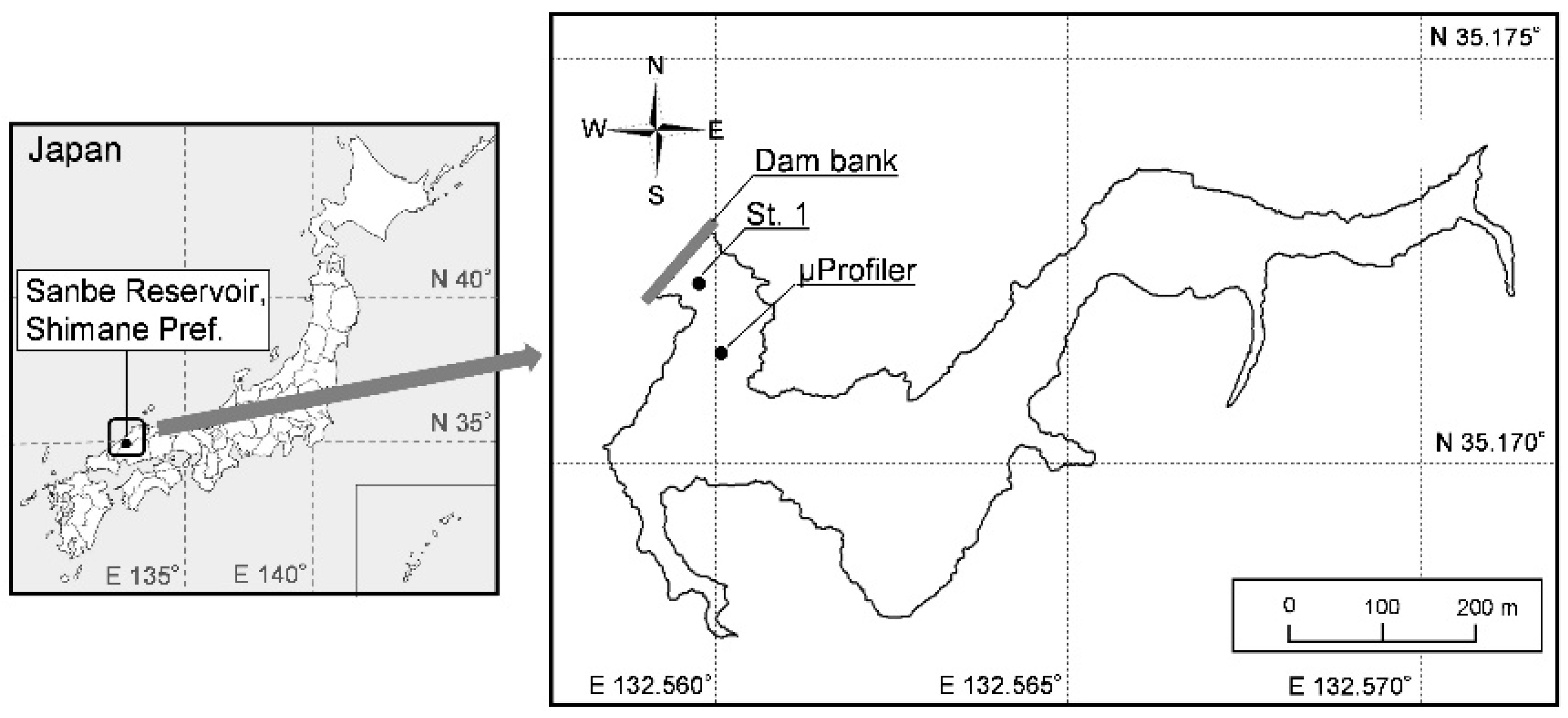
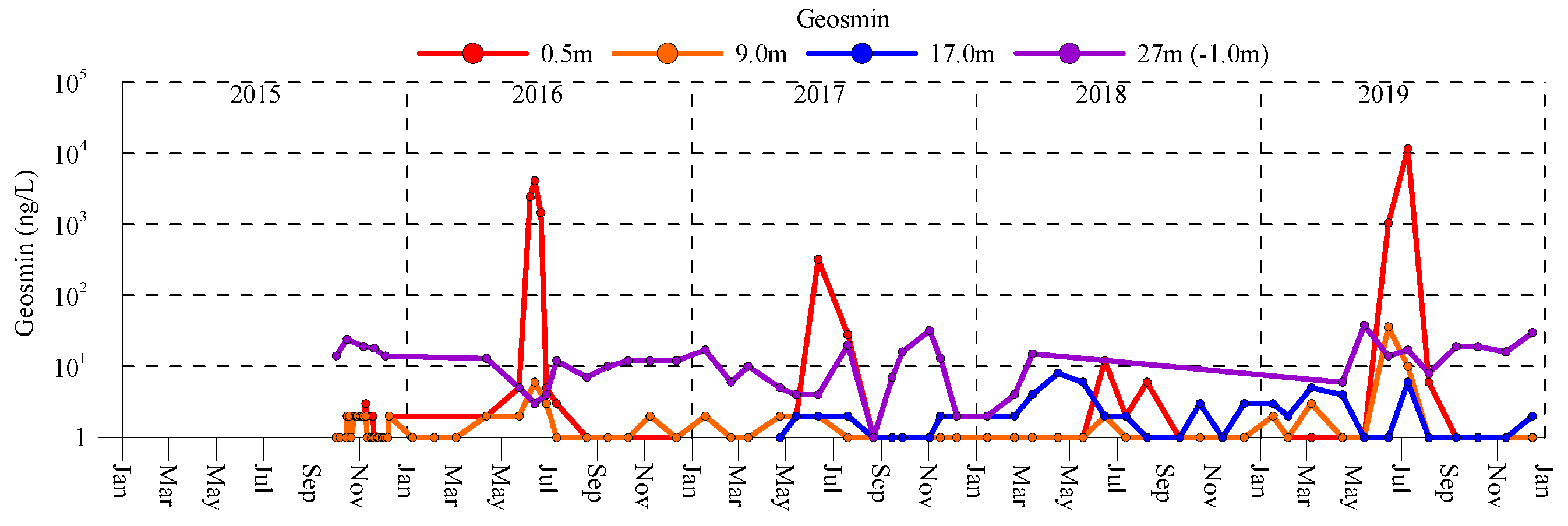
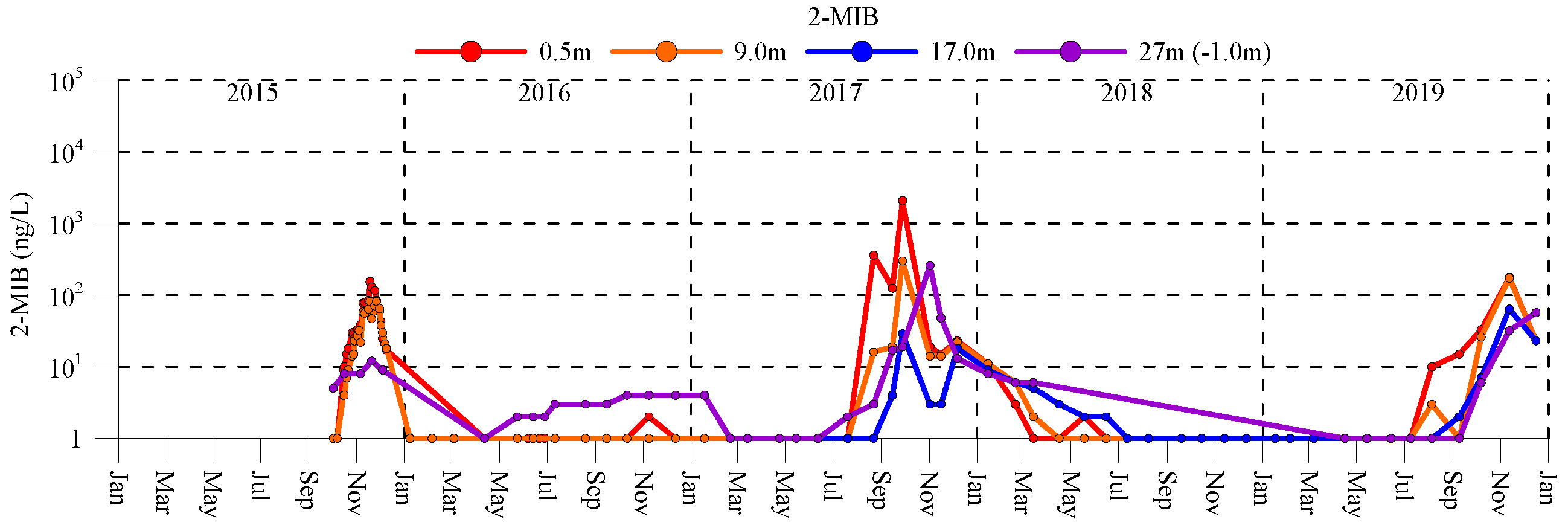
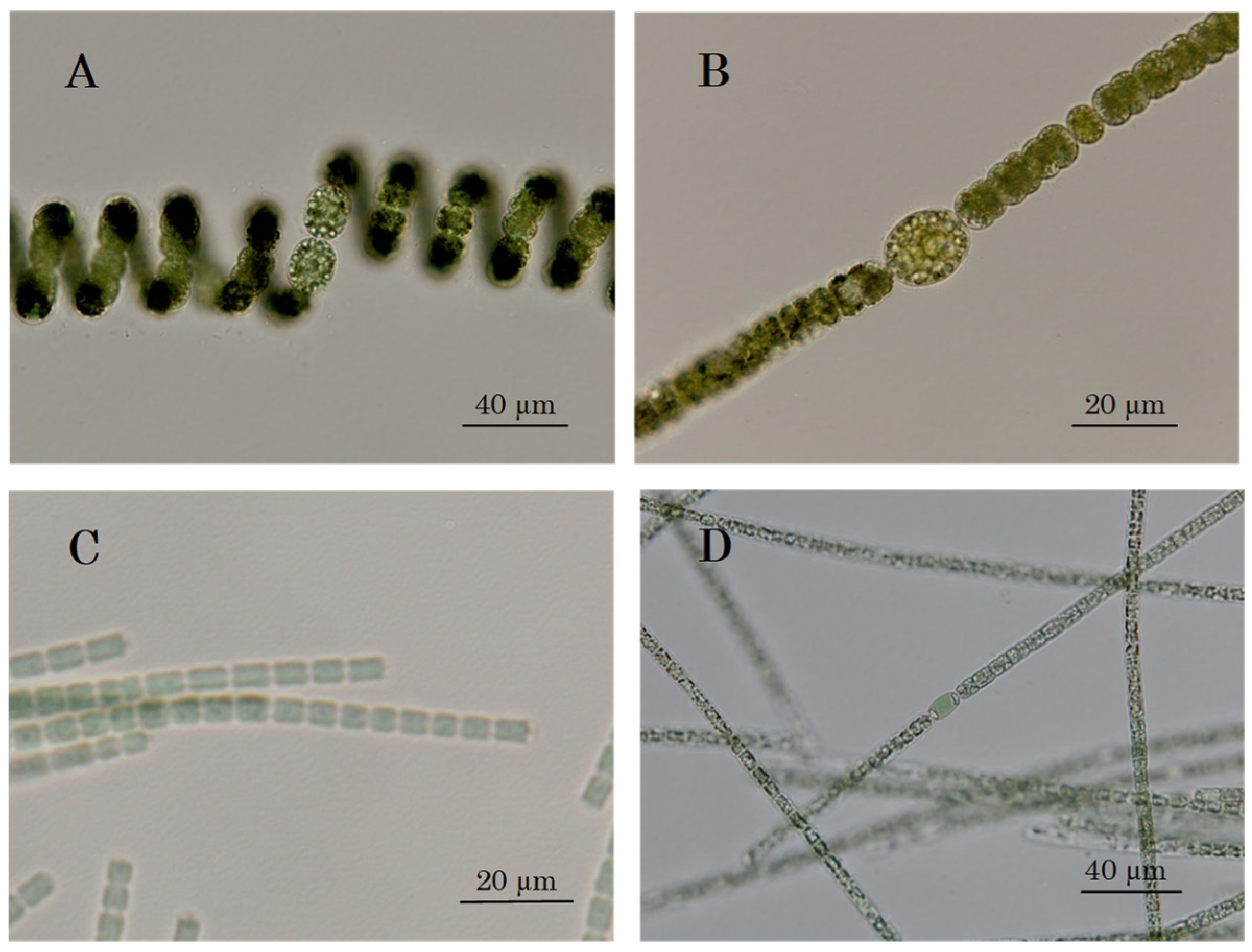
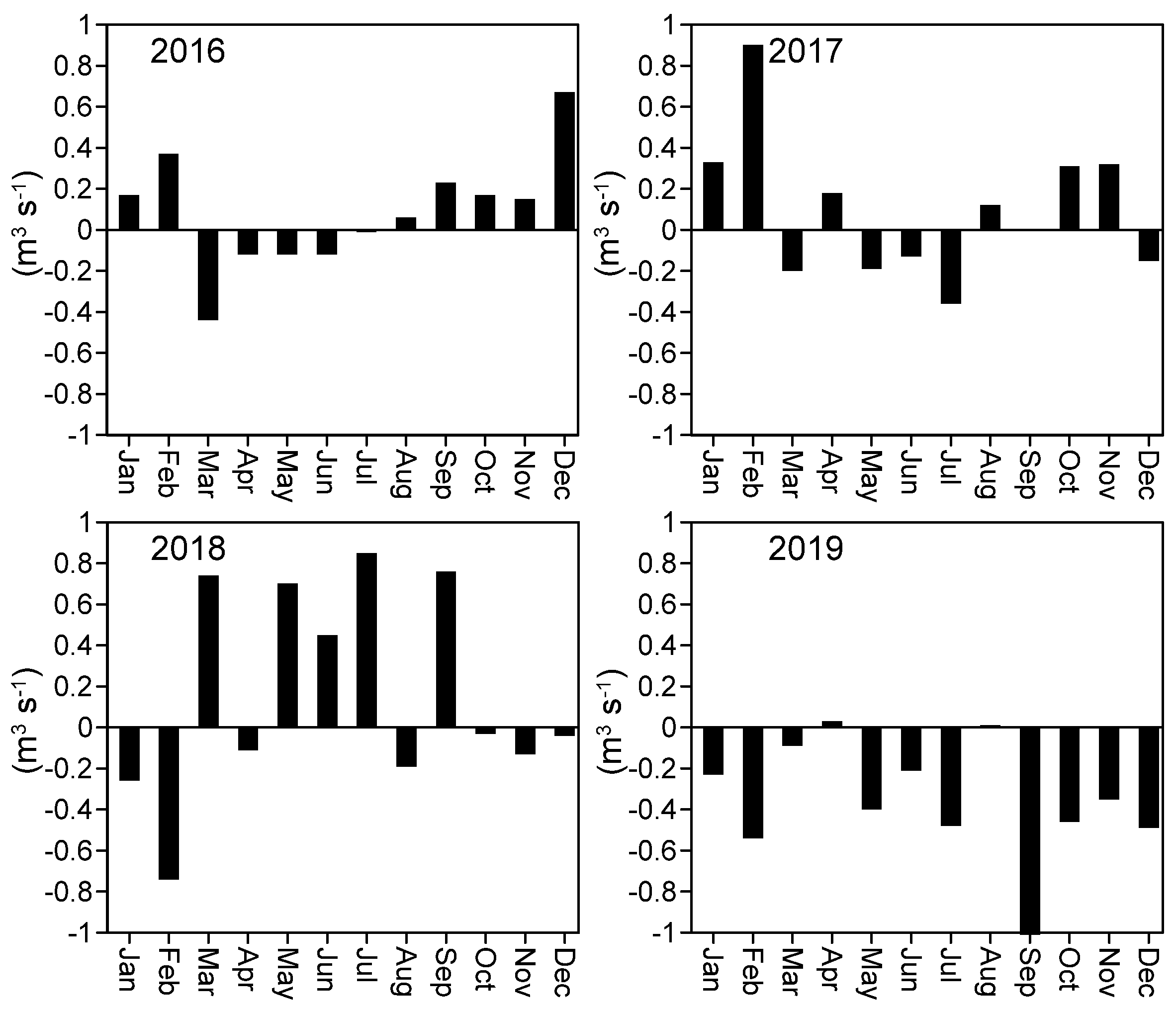


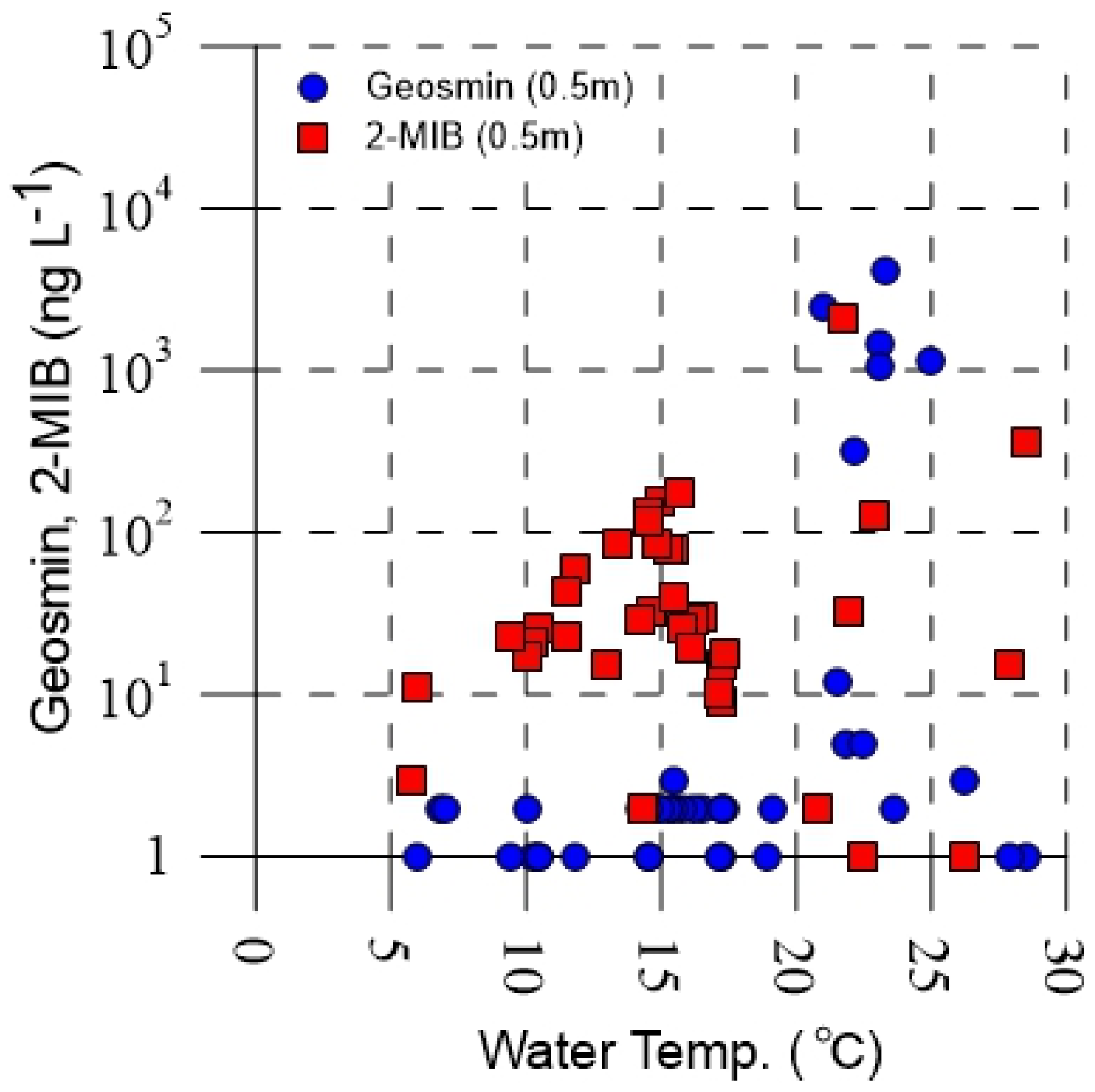
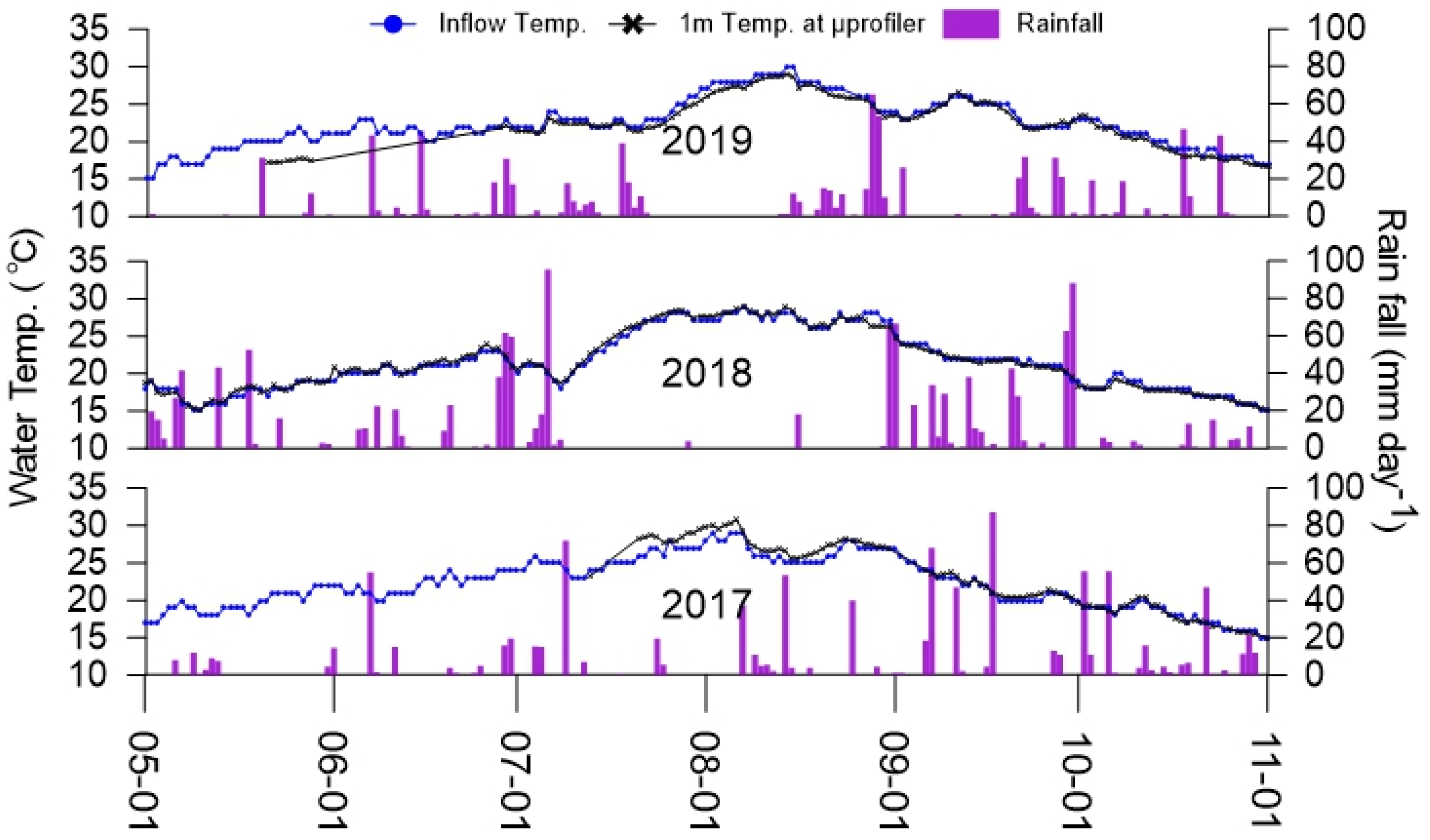
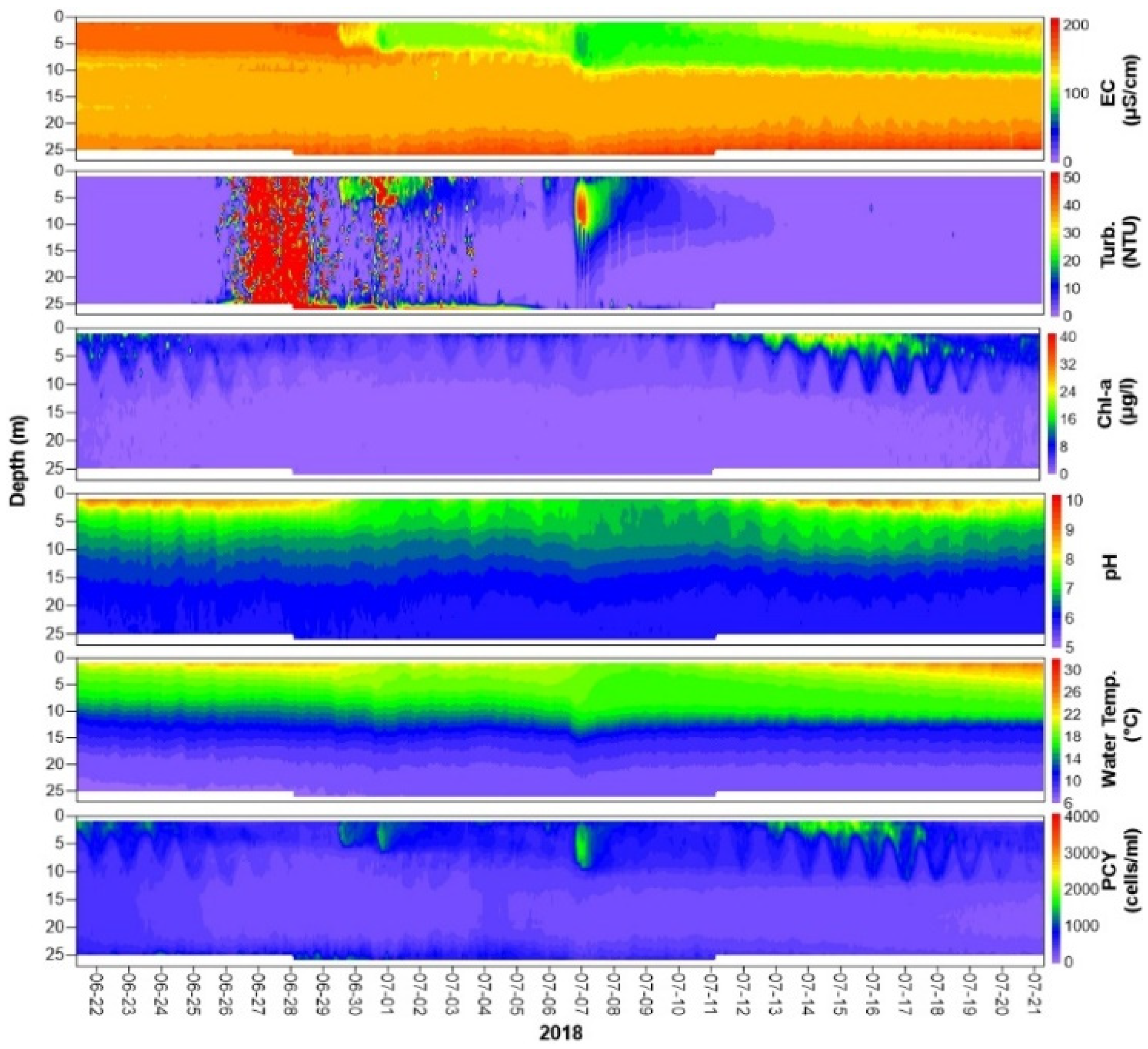
| Sampling Date Sampling Depth Odor in the Field | 22 June 2017 0.5 m Geosmin | 1 September 2017 0.5 m 2-MIB | 27 June 2019 1 m Geosmin | 25 September 2019 1 m 2-MIB |
|---|---|---|---|---|
| Aphanocapsa sp. | − | rr | − | r |
| Aphanothece sp. | − | r | − | − |
| Microcystis novacekii | − | − | − | rr |
| Microcystis sp. | − | − | r | r |
| Woronichinia naegeliana | − | − | rr | − |
| Pseudanabena sp. *1 | − | r | − | + |
| cf. Geitlerinema sp.*3 | − | c | − | c |
| cf. Cuspidothrix sp.*3 | + | − | rr | − |
| Aphanizomenon cf. flos−aquae *1 | − | − | − | c |
| Dolichospermum crassum *2 | r | − | + | − |
| Dolichospermum planctonicum *2 | − | − | c | − |
Publisher’s Note: MDPI stays neutral with regard to jurisdictional claims in published maps and institutional affiliations. |
© 2021 by the authors. Licensee MDPI, Basel, Switzerland. This article is an open access article distributed under the terms and conditions of the Creative Commons Attribution (CC BY) license (https://creativecommons.org/licenses/by/4.0/).
Share and Cite
Kim, S.; Hayashi, S.; Masuki, S.; Ayukawa, K.; Ohtani, S.; Seike, Y. Effect of Rainfall and pH on Musty Odor Produced in the Sanbe Reservoir. Water 2021, 13, 3600. https://doi.org/10.3390/w13243600
Kim S, Hayashi S, Masuki S, Ayukawa K, Ohtani S, Seike Y. Effect of Rainfall and pH on Musty Odor Produced in the Sanbe Reservoir. Water. 2021; 13(24):3600. https://doi.org/10.3390/w13243600
Chicago/Turabian StyleKim, Sangyeob, Shohei Hayashi, Shingo Masuki, Kazuhiro Ayukawa, Shuji Ohtani, and Yasushi Seike. 2021. "Effect of Rainfall and pH on Musty Odor Produced in the Sanbe Reservoir" Water 13, no. 24: 3600. https://doi.org/10.3390/w13243600





